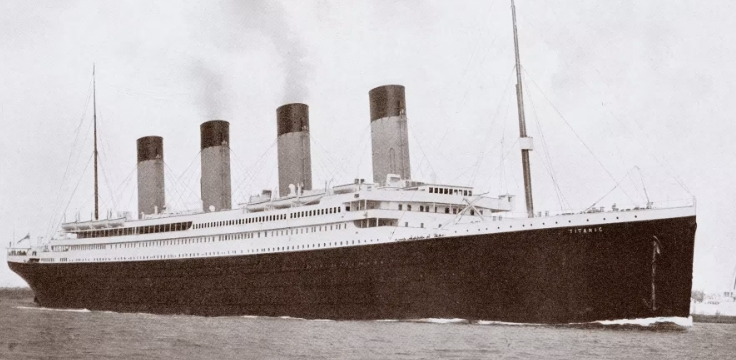If you are looking for a sad story of a ship sinking to the bottom of the ocean. Here you are, the RMS Titanic, a luxury steamship, sank in the early hours of April 15, 1912, off the coast of Newfoundland in the North Atlantic after sideswiping an iceberg during its maiden voyage. Of the 2,240 passengers and crew on board, more than 1,500 lost their lives in the disaster. Titanic has inspired countless books, articles, and films (including the 1997 Titanic movie starring Kate Winslet and Leonardo DiCaprio), and the ship’s story has entered the public consciousness as a cautionary tale about the perils of human hubris.
On May 31, 1911, Titanic’s immense hull–the largest movable manmade object in the world at the time–made its way down the slipways and into the River Lagan in Belfast. More than 100,000 people attended the launching, which took just over a minute and went off without a hitch.
The hull was immediately towed to a mammoth fitting-out dock where thousands of workers would spend most of the next year building the ship’s decks, constructing her lavish interiors and installing the 29 giant boilers that would power her two main steam engines.
Unsinkable’ Titanic’s Fatal Flaws
According to some hypotheses, Titanic was doomed from the start by a design that many lauded as state-of-the-art. The Olympic-class ships featured a double bottom and 15 watertight bulkhead compartments equipped with electric watertight doors that could be operated individually or simultaneously by a switch on the bridge.
It was these watertight bulkheads that inspired Shipbuilder magazine, in a special issue devoted to the Olympic liners, to deem them “practically unsinkable.”
But the watertight compartment design contained a flaw that was a critical factor in Titanic’s sinking: While the individual bulkheads were indeed watertight, the walls separating the bulkheads extended only a few feet above the water line, so water could pour from one compartment into another, especially if the ship began to list or pitch forward.
The second critical safety lapse that contributed to the loss of so many lives was the number of lifeboats carried on Titanic. A mere 16 boats, plus four Engelhardt “collapsibles,” could accommodate just 1,178 people. Titanic could carry up to 2,435 passengers, and a crew of approximately 900 brought her capacity to more than 3,300 people.
As a result, even if the lifeboats were loaded to full capacity during an emergency evacuation, there were available seats for only one-third of those on board. While unthinkably inadequate by today’s standards, Titanic’s supply of lifeboats actually exceeded the British Board of Trade’s requirements.
Passengers on the Titanic
Titanic created quite a stir when it departed for its maiden voyage from Southampton, England, on April 10, 1912. After stops in Cherbourg, France, and Queenstown (now known as Cobh), Ireland, the ship set sail for New York with 2,240 passengers and crew—or “souls,” the expression then used in the shipping industry, usually in connection with a sinking—on board.
The wealthiest passenger was John Jacob Astor IV, heir to the Astor family fortune, who had made waves a year earlier by marrying 18-year-old Madeleine Talmadge Force, a young woman 29 years his junior, shortly after divorcing his first wife.
Other notable passengers included the elderly owner of Macy’s, Isidor Straus, and his wife Ida; industrialist Benjamin Guggenheim, accompanied by his mistress, valet and chauffeur; and widow and heiress Margaret “Molly” Brown, who would earn her nickname “The Unsinkable Molly Brown” by helping to maintain calm and order while the lifeboats were being loaded and boosting the spirits of her fellow survivors.
Titanic Sets Sail
Titanic’s departure from Southampton on April 10 was not without some oddities. A small coal fire was discovered in one of her bunkers–an alarming but not uncommon occurrence on steamships of the day. Stokers hosed down the smoldering coal and shoveled it aside to reach the base of the blaze.
After assessing the situation, the captain and chief engineer concluded that it was unlikely it had caused any damage that could affect the hull structure, and the stokers were ordered to continue controlling the fire at sea.
According to a theory put forth by a small number of Titanic experts, the fire became uncontrollable after the ship left Southampton, forcing the crew to attempt a full-speed crossing; moving at such a fast pace, they were unable to avoid the fatal collision with the iceberg.
Another unsettling event took place when Titanic left the Southampton dock. As she got underway, she narrowly escaped a collision with the America Line’s S.S. New York. Superstitious Titanic buffs sometimes point to this as the worst kind of omen for a ship departing on her maiden voyage.
The Titanic Strikes an Iceberg
Here is the reason right here. On April 14, after four days of uneventful sailing, Titanic received sporadic reports of ice from other ships, but she was sailing on calm seas under a moonless, clear sky.
At about 11:30 p.m., a lookout saw an iceberg coming out of a slight haze dead ahead, then rang the warning bell and telephoned the bridge. The engines were quickly reversed and the ship was turned sharply—instead of making direct impact, Titanic seemed to graze along the side of the berg, sprinkling ice fragments on the forward deck.
This Story is in the writing of Shane and described by me, the Author in other words. I read stuff and write stuff, and I want my stories for the world to see and read.

Your comment will appear immediately after submission.